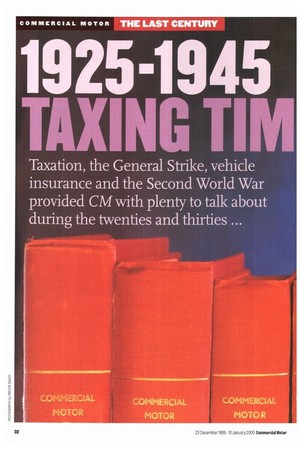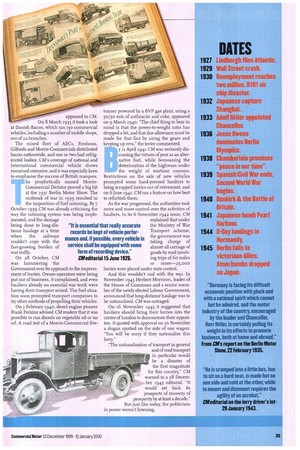11925 1945
Page 34

Page 35

Page 36

Page 37

If you've noticed an error in this article please click here to report it so we can fix it.
TAX NO TIM
Taxation, the General Strike, vehicle insurance and the Second World War provided CM with plenty to talk about
during the twenties and thirties ... Taxation and the use made of the money raised by it was very much on Commercial Motor's mind at the start of1926. An editorial published on 2 February that year objected to any plans Chancellor of the Exchequer, Winston Churchill, might have to raid the Road Fund and use the cash for general spending.
CM's fears were realised. Churchill relieved the Road Fund, which then stood at i19m, of £7m, which was redirected to projects other than highways. The magazine protested but, alas, to no avail. In 1927 Churchill raided the Fund again, this time milking it for LI2M..
The Chancellor added insult to injury by raising the tax paid on lorries with a payload of five tons or more to go a year from the previous L30. Other weight categories suffered increases too; owners of lonies with a payload from one to two tons had to pay L26, up from £21.
But CM soon had other things to worry about. There was no II May1926 issue due to the General Strike. The magazine reappeared the following week, however. "Road transport was the rock upon which the big stick (ie, the strike weapon) was broken," it proclaimed, illustrating its point with a photograph of a convoy of lorries in London's Victoria 8r. Albert docks which had been loaded by volunteer labour.
Each lorry had an armed guard sitting next to the driver, and the convoy was protected by armoured cars and mounted policemen.
On 5 August 1930 CM reported on a piece of legislation which in many respects forms the bedrock of all the subsequent rules and regulations governing the operation of vehicles. The Road Traffic Act of that year introduced, among other things, compulsory third party insurance, limits on driving times, a new offence of careless driving, and the requirement that licence holders make a statutory declaration of their fitness to drive.
Two years previously, on ix December '928, CM had expressed doubts about the wisdom of compulsory third party cover. "If we start with road traffic, we must logically provide for the thousands of risks we all run in life," an editorial mused.
Of far greater direct importance to hauliers was the Road & Rail Traffic Act 1933, which set up a system of licences that pre-dated the current Operator's Licence system. An A-licence was a hire-or-reward haulier's licence; a Blicence permitted the holder to haul other people's goods as well as his own; while a C-licence was for own-account operators only.
The act also laid down requirements which licence holders had to meet in respect of the fitness of their lorries, the observation of weight and speed limits, and adherence to the drivers' hours rules. The hours worked had to be logged.
The licensing authorities had the power to suspend or revoke licences if the company broke the regulations. Firms already providing transport services could object to the grant of licences on the grounds that suitable transport services already existed, and any new service would be in excess of what was required.
As long-distance haulage expanded during
the thirties, the railway quently objected to the according to CM. In a 5 March 1937 editorial it talked about "the drastic efforts which are likely to be made by the railways in their attempts to cripple road transport".
But CM was happy to acknowledge that road and rail could work in harmony too. On I March 1935 it ran a feature on how the Co-op was using 12 road/rail tankers to haul milk from the country into London.
rf0y1935 drivers had to pass a test before
companies also fregrant of A-licences, they were allowed to get behind the wheel of a lorry as a result of the Road Traffic Act 1934. By the thirties minimum wage legislation was also in place, with minimum rates for the haulage sector laid down by the Joint Conciliation Board and local Area Boards.
Impose regulations, and people will find ways to circumvent them. CMwas soon highlighting the number of unlicensed hauliers who were trading, and complaints about illegal operations rapidly became as familiar as complaints about rate cutting.
One Captain EHB Palmer roundly con demned these early cowboys on 12 March 1937. "One hesitates to report a neighbour, but I have encountered some of these neighbours and have been amazed at their cunning and audacity" he stated. "Every day in every way these blacklegs prove their utter unsuitability for admission to or retention in an industry that is fighting hard for recognition."
Throughout the twenties and thirties CM published a string of technical articles and road tests. In its 5 May 1931 issue, for example, it put a Scammell artic through its paces. The outfit had a 4X2 tractor unit, a tandem axle trailer, a 14-ton payload, and averaged 5.mpg on a run from Watford to Aylesbury and back.
Whereas in 1926 the sources of power were either petrol or steam, diesel increasingly made its presence felt in the years up to the outbreak of the Second World War. On 25 March 1930, CM published a test of a Mercedes diesel-engined six-wheeler with a nine-ton, r3cwt load on board, and was impressed. It averaged 9mpg at an average 19.3mph, accelerated from o to 22rnph in 30 seconds, and offered a maximum speed of 23mph.
Even in 1930, some operators were con templating converting their existing lorries from petrol to diesel power. On 22 July of
that year, CM reported that a Mr TH Parkinson had installed a 5.6-litre Gardner diesel in a Leyland RAF type chassis, and was getting 17.3mpg out of it.
Three years later (CM 16 June 1933) it reported that Pelican Engineering had developed a thriving business swapping petrol engines in lorries for Gardner diesels.
ome 29 September 1933 CM was 6Altesting a Leyland Beaver powered by a 9ohp eight-litre, six-cylinder diesel. It returned ro.3mpg at an average 17.5mph with a six-ton i4cwt payload. At this stage it's worth noting that CM wasn't just about vans and trucks. It covered the bus and coach scene extensively, and many of the municipal buses were trolley buses.
One of the more fascinating articles on coach operation was a 21 August 1928 feature on the introduction of an overnight sleeper coach service between London and Liverpool operated by Albatross Roadways. The doubledecker accommodated 12 passengers, and at 25s the fare was considerably cheaper than the 575 charged by the railway sleeper service.
CM had also developed an interest in aviation, and by the 1930s was producing Air Transport as a regular supplement. On 24 November 1933 it reported on an Imperial Airways flight from Croydon—then an important airport—to Paris. "The whole journey was so easy, there were so few formalities, no trouble at all with luggage, and courtesy shown everywhere, that one can only express surprise that more people do not take advantage of air travel."
Then, as now, operator profiles regularly
appeared in CM. On 8 March 1935 it took a look at Danish Bacon, which ran 130 commercial vehicles, including a number of mobile shops, out of 22 branches.
The mixed fleet of AECs, Fordsons, Gilfords and Morris-Commercials distributed bacon nationwide, and one or two had refrigerated bodies. CM's coverage of national and international commercial vehicle shows remained extensive, and it was especially keen to emphasise the success of British marques.
he prophetically named MorrisCommercial Dictator proved a big hit at the 1931 Berlin Motor Show. The outbreak of war in 1939 resulted in the imposition of fuel rationing. By 7 October /939 CM was already criticising the way the rationing system was being implemented, and the damage being done to long-distance haulage at a time when the railways couldn't cope with the fast-growing burden of war traffic.
On 28 October, CM was hammering the Government over its approach to the impressment of lorries. Owner-operators were being put out of business, it complained, and even hauliers already on essential war work were having their transport seized. The fuel situation soon prompted transport companies to try other methods of propelling their vehicles.
On 3 February 194o, diesel engine pioneer Frank Pericins advised CM readers that it was possible to run diesels on vegetable oil or tar oil. A road test of a Morris-Commercial five
tonner powered by a BVP gas plant, using a 50/50 mix of anthracite and coke, appeared on 9 March '940, "The chief thing to bear in mind is that the power-to-weight ratio has dropped a bit, and that due allowance must be made for that fact by using the gears and keeping up revs," the tester commented,
y ri April 1941 CM was seriously discussing the virtues of peat as an alternative fuel, while bemoaning the deterioration of the highways under the weight of wartime convoys. Restrictions on the sale of new vehicles prompted some hard-pressed hauliers to bring scrapped lorries out of retirement, and on fl June 1941, CM ran a feature on how best to refurbish them.
As the war progressed, the authorities took more and more control over the activities of hauliers. In its 6 November 1942 issue, CM explained that under the Ministry of War Transport scheme, the government was taking charge of almost all carriage of goods by road involving trips of 6o miles or more-25,000 lorries were placed under state control.
And this wouldn't end with the war. In November 1945 Herbert Morrison, leader of the House of Commons and a senior member of the newly elected Labour Government, announced that long-distance haulage was to be nationalised. CM was outraged.
On 16 November 1945 it suggested that hauliers should bring their lorries into the centre of London to demonstrate their oppositon. It quoted with approval on 30 November a slogan spotted on the side of one wagon: "You will be sorry if they nationalise this lorry" "The nationalisation of transport in general and of road transport in particular would be a disaster of the first magnitude
it is essential that really accurate records be kept of vehicle performance and, if possible, every vehicle in service shall be equipped with some form of recording device." CMeditoria115 June 1926.
for this country," CM warned in a 28 December 1945 editorial. "It would set back its prospects of recovery of prosperity by at least a decade."
But just like today, the politicians in power weren't listening.
DATES
1927 :,indbergh flies Atlantic. 1929 all Street crash.
1930 inemployment reaches
two million. R101 air ship disaster.
1932 Japanese capture Shanghai.
1933 Adolf Hitler appointed Chancellor.
1936 Jesse Owens
dominates Berlin
1938 ';'hamberlain promises "peace in our time".
1939 Spanish Civil War ends. lecond World War begins.
1940 Dunkirk & the Battle of Britain.
1941 Japanese bomb Pearl Harbour.
1944 D-Day landings in Normandy.
1945 Berlin falls to
victorious Allies.
Atom bombs dropped on Japan.
"Germany is facing its difficult economic position with pluck and with a national spirit which cannot but be admired, and the motor industry of the country, encouraged by the leader and Chancellor, Herr Hitler, is certainly pulling its weight in its efforts to promote business, both at home and abroad." From Offs report on the Berlin Motor Show, 22 February 1935.
"He is cramped into a little box, has to sit on a hard seat, is made hot on one side and cold at the other; while to mount and dismount requires the agility of an acrobat." CMeditorial on the lorry driver's lot 29 January 1943.




















































































































































